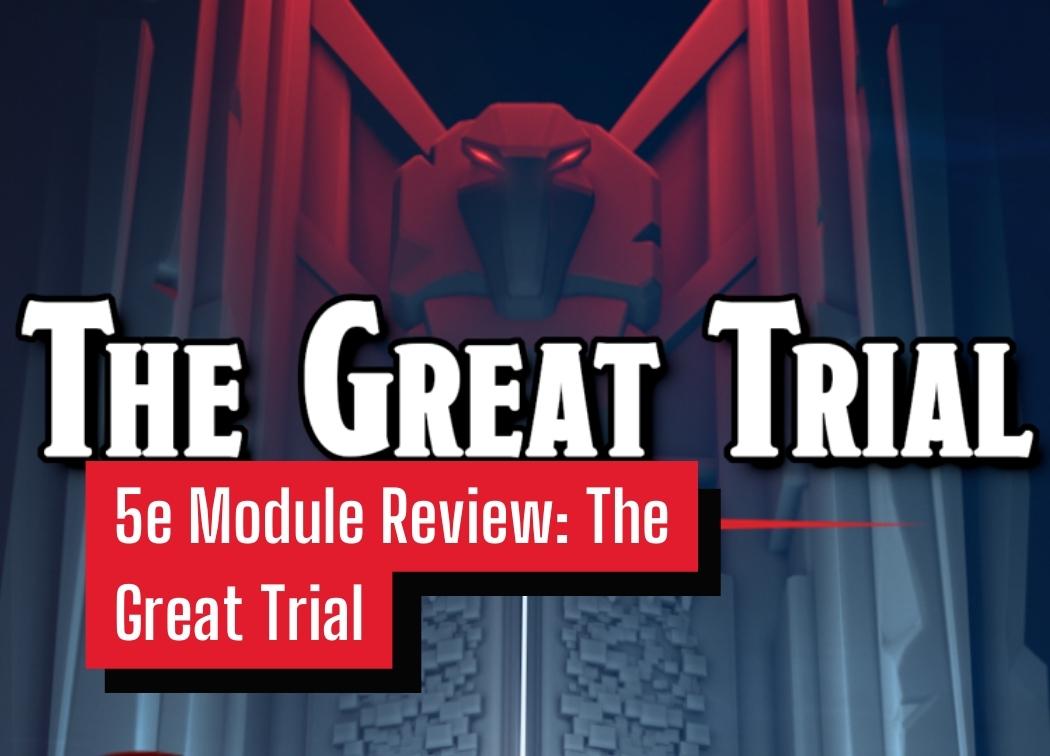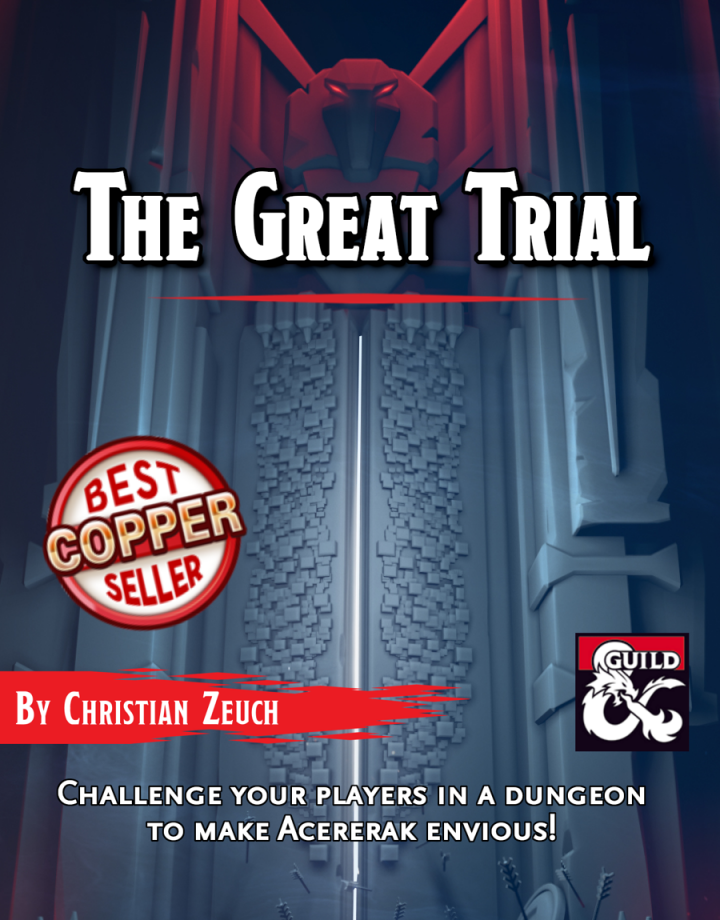5e Module Review: The Great Trial

Christian Zeuch is a newer DMs Guild creator who has hit the ground running. From encounter packs to map packs, he’s released a ton of great additions to the various 5e hardback releases.
Christian has also released a few of his own adventures. The Great Trial is one of his adventures and is a love-letter to some of D&D’s most iconic dungeons. Yet, while it certainly takes inspiration from adventures like Tomb of Horrors, it has a distinct identity and plenty of unique mechanics.
I’m a sucker for dungeon delves, and my friends all jump at the chance to play mid to high-level adventures. Needless to say, The Great Trial was a shoo-in for a one-shot at my table. We had a lot of fun with this one and it kept us occupied for just under five sessions.
It’s a flexible module, it works as a standalone one-shot or it can be easily slotted into an ongoing campaign. It’s even flexible enough to be broken up by layer. This plus its awesome maps make it a great tool or inspiration for any DM’s hoard.
Let’s get into the nitty-gritty of this great dungeon crawl so I can convince you to throw this one onto your DMs Guild holiday wishlist!
Formatting and Editing
The formatting is standard 5e fair. The PDF is searchable and the Table of Contents contains links to each page, making it easy to navigate during game night. All in all, it’s solid.
However, the module could use extra editing. Many sections were overly-wordy making them difficult to read and they required a couple of pass-throughs before I fully understood them.
The boxed text also suffered from this issue and made descriptions difficult to explain to the party in quite a few instances. These didn’t wind up punishing the party in-game, but I had to reread or have cliff notes prepared to explain the scene.
Background Info
The Great Trial is a series of challenges created by Aenor Gleenwith, an elf wizard. Aenor is a master of magic and engineering and decided to put his tools to the test and create his magnum opus – The Great Trial.
There are deadly traps, vicious monsters, and exhausting puzzles peppered throughout the halls of The Great Trial. Adventurers will need every ounce of their skill and wit to pass the challenges Aenor placed.
However, the dungeon is not complete. Presently, Aenor needs to test the dungeon. To do so, he’s discovered a crack QA team, the party.
The adventure has a few suggested plot hooks to help steer the party in Aenor’s direction. However, it’s not a super difficult premise to come up with one yourself. This is not a lore-heavy adventure by any means.
In fact, I’d say that’s one of the module’s strengths. It’s adaptable for any campaign.
Maps
As someone who has been playing TTRPGs virtually for years, I always get excited when a DMs Guild module includes virtual maps and battlemaps. It’s nice to slap a map into Roll20 and do some minor edits rather than figure out how to grab each map out of a PDF and hope they look decent.
The Great Trial includes 13 unique maps. Which is a respectable amount as-is.
However, almost every map includes at least a gridless version of the map. The overworld maps also include a DM version and a player version as well. Plus, a few maps include a map with its lighting in-place.
All the maps look fantastic. In fact, they look so awesome, they’ve convinced me to check out Dungeondraft!
Running the Module
Each level of The Great Trial is, effectively, a different dungeon.
- 1st Floor: classic dungeon crawl with tons of traps
- 2nd Floor: skill challenge to navigate your way out of a maze
- 3rd Floor: hexcrawl
This diversity creates a unique dungeon crawling experience, but it does require the DM to know how to run a few different types of scenarios. Thankfully, there’s ample instruction in the module on how to run any of the floors.
I’d also recommend that if you’re running The Great Trial as a one-shot you should mention that there are few social interactions within the dungeon. The adventure is geared towards combat and exploration, so someone rolling up a face-type character is at a heavy disadvantage.
Keep in mind too that the party has a limited supply of food and water until they get to the open-world hexcrawl. There’s a sense of urgency that’s pressed upon the party in the first two floors, both of which are loaded with deadly creatures and traps!
Encounter Balance
The encounters as a whole were fantastic. The first two floors in particular were phenomenal with regards to encounter design and balance. There were plenty of tough fights on these floors, but they always felt fair.
This was impressive since there were tons of deadly traps on these floors. The party was often low on resources, yet had to press on to avoid starving to death. However, I still never felt the party was in danger of a TPK.
Each important fight also had a strategy section included in their description. This was a welcomed addition even for someone whose piloted many of these creatures before. It gave me some insight into the intended design process and was helpful with my decision-making during the session.
I’d love to see more modules include a quick strategy blurb like these for important fights!
Multiple Ways to Solve a Problem
A number of the fights in this module had alternative solutions. These often require some creative thinking but reward the players by reducing the difficulty of the encounter. This is a huge boon for the party considering that they’re pressed for time due to their lack of food and water!
One example is the aboleth fight. The aboleth is protecting what appears to be a slime-covered egg from the party. Suffice to say it makes sense that the creature would protect its baby. However, if the party removes the slime coating, they reveal that the egg is actually a giant sapphire.
They can then convince the aboleth that Aenor tricked them. In doing so, the aboleth will cease its assault and allow the party to leave, shifting its focus on getting revenge on Aenor the next time he visits their domain.
I thought these alternative solutions were really cool. They provided an alternative route to victory while also encouraging creative thinking. However, the fights were still entirely doable without these creative solutions.
Floor 1: The Entry Level
This was by far my group’s favorite level of the adventure. It was a classic dungeon crawl that took plenty of inspiration from the Tomb of Horrors.
There were tough fights, desperate struggles, and obnoxious traps. It was awesome.
The traps were the highlight of this level for sure. They’re deadly, especially if your group opts to play with the suggested Injuries rule from the DMG. Yet, they’re also creative. Each one is distinct and has different mechanics to keep the party on its toes.
However, even the most attentive parties will fall for quite a few of these deadly traps
The overall goal of this level was simple. You get the keys to open the doors, then you get the three gemstone MacGuffins to open the door to the next floor. All the while you must avoid traps and conquer various foes.
Floor 2: The Labyrinth Level
Initially, I assumed that the labyrinth level would involve a classic crawl through a maze of ever-winding corridors. Thematically, it does, but gameplay-wise it’s a unique take on navigating a labyrinth.
The labyrinth functions as a skill challenge, in which the party must succeed on a total of 10 skill checks (Perception, Insight, Investigation, or History) to reach the end of the labyrinth.
Each failure results in one of the following: a trap, dead-end, random encounter, or an illusionary wall that, when interacted with will grant the party a free success. The traps are quite deadly. The encounters, on the other hand, felt a bit too easy.
After a set of two or three skill checks, the party may be brought to a room outside of the labyrinth. The initial set brings them to one of two puzzle rooms. If they solve the puzzle, they disable one of the Minotal’s traits or abilities, making their fight against this miniboss easier.
At five successes, they fight the minotal, a metallic construct inspired by a minotaur. This was my favorite encounter. The creature was really fun to pilot, but I also enjoyed how completing the optional puzzles gave the party a sense of progression by weakening the minotal.
After ten checks, the party reaches the end of the labyrinth. There, they fight yet another metallic construct, this time inspired by a wyvern. This was a deadly fight, especially when you take into account all the damage the party took from the various encounters and traps as they navigated the labyrinth.
All in all, this was a fantastic take on a traditional labyrinth and definitely something I’ll steal the next time I want to add a labyrinth or a maze to an adventure. If anything, I’d have liked to play around more in this level. It felt a bit too quick, but it was very fun while it lasted.
Floor 3: The “Halaster” Level
Once the party escapes the labyrinth they walk up a flight of stairs that lead into a cave where there is a literal light at the end of the tunnel. They’re finally free of the horrible, deadly dungeon, right?
Wrong! They’ve been thrown into the third, and final (unbeknownst to them) level of The Great Trial! They must endure a dinosaur-riddled hellscape that features a variety of biomes to traverse, each with their own challenges.
Each biome has a unique list of random encounters as well as some additional environmental effects. For instance, food is abundant and easily accessible in the hills, but the jungle is more difficult to forage in due to the dangerous creatures that inhabit it.
There are also a bunch of suggested unique encounters to run as the party traverses different areas.
The Ruins
The goal of this level is to deactivate the pillars of light that shoot out from three separate ruins spread across the map. Each of the ruins serves as a small mini-dungeon with unique challenges. Once they’ve been deactivated, the party can leave this floor by returning to the original cave they arrived in.
Each of the three ruins had a different set of challenges:
- Mountain Ruin: skill challenge to climb the tower
- Lake Ruin: pass through the trap gauntlet and complete the riddle puzzle
- Island Ruin: fight the Furious Zombie Ape
The mountain and lake ruins were solid. The lake ruin’s gauntlet was especially fun and posed a real challenge to the party.
The island ruin, however, needs some added challenge to it. The furious zombie ape is easy for a party to crowd control and blast to bits. I think it needed some legendary actions or a bunch of minions to tip the scales in its favor.
Final Thoughts on The Great Trial
All in all, we a blast playing through this module the four and a half weeks it took them to climb out of Aenor Gleenwith’s dastardly dungeon.
The Great Trial doesn’t require a lot of background to run or much of a story at all. This makes it a fantastic adventure to slot into a campaign for a few weeks. Plus, its modularity opens it up further, allowing you to run a single floor as a one-off dungeon if you so choose.
For just under $7, The Great Trial is worth the price point. There’s at least five sessions worth of content in here plus a boatload of well-made maps that you can slap right into your VTT of choice.

